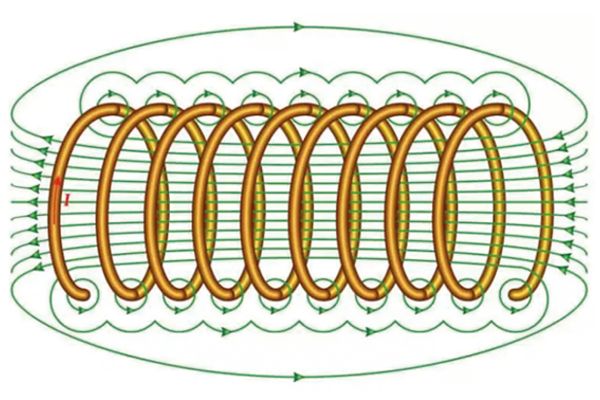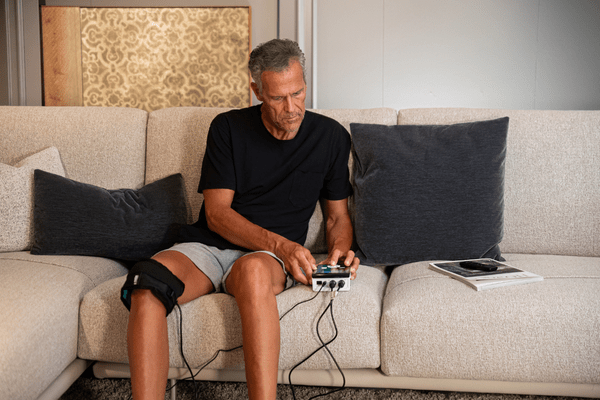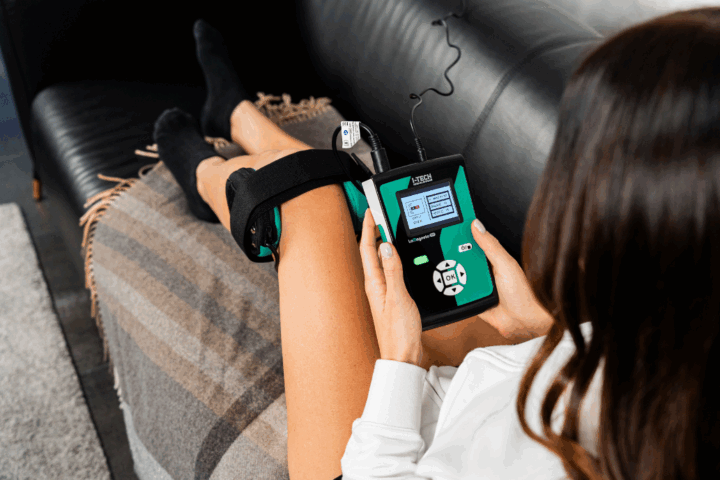La magnetoterapia a bassa frequenza e alta intensità consiste in un dispositivo che emette campi elettromagnetici pulsati (CEMP) trasferiti al paziente tramite solenoidi. I CEMP sono particolarmente indicati per il trattamento di patologie a carico dei tessuti ossei, ma evidenze importanti si hanno anche nel trattamento di problematiche di tipo muscolo-legamentoso.
Cosa sono i solenoidi nella magnetoterapia
Un solenoide può essere rappresentato come un filo di rame avvolto, simile ad una molla. Lungo il filo viene fatta passare una piccola quantità di corrente che genera un campo magnetico, le cui linee di forza generano un campo magnetico orientato da un polo nord a un polo sud, analogamente a quello di un magnete.
Nell’uso terapeutico, gli avvolgimenti possono essere schiacciati e il solenoide assume una forma piatta che viene messa a contatto con la parte del corpo da trattare, ad eccezione dei solenoidi a cilindro dove il paziente viene posizionato all’interno dell’applicatore stesso.
La forma fisica dei solenoidi varia da fabbricante a fabbricante. Possono essere circolari, rettangolari o cilindrici e venire usati singolarmente oppure contenuti insieme in una fascia.
Indipendentemente dalla forma, è fondamentale che i solenoidi siano in grado di generare campi magnetici con intensità e frequenza adeguate all’applicazione prevista.

Ma adeguati a cosa?
Ogni dispositivo per magnetoterapia deve essere dotato della marcatura CE come dispositivo medico, che ne attesta la conformità alla normativa europea vigente.
Queste norme sono fondamentali per garantire la sicurezza e la salute del paziente.
Assicurati sempre di richiedere al fabbricante la documentazione che certifica la conformità del dispositivo alle direttive europee applicabili.
Nei dispositivi di magnetoterapia a bassa frequenza e alta intensità il campo magnetico viene misurato in Gauss.
Studi clinici hanno dimostrato l’efficacia dei campi magnetici a partire da intensità molto basse (da 5 Gauss fino a 300 Gauss). Non esiste tuttavia una relazione diretta tra intensità e durata del trattamento. Questo significa che non si può affermare che aumentando l’intensità del campo magnetico è possibile diminuire il tempo di trattamento al di sotto dei tempi fisiologicamente necessari affinché la terapia sia efficace.
Un elemento che risulta comune a tutti gli studi è rappresentato dalla necessità di effettuare trattamenti di magnetoterapia per tempi mediamente lunghi (45-90 giorni), per almeno 2-4 ore al giorno.
L’efficacia della magnetoterapia a bassa frequenza e alta intensità è riportata in numerosissimi studi clinici che dimostrano come i campi magnetici pulsati a bassa frequenza siano particolarmente indicati per il trattamento delle patologie ossee.
Benefici della magnetoterapia
La magnetoterapia offre numerosi benefici grazie all’uso di campi elettromagnetici pulsati. Questi campi stimolano le cellule, ripristinando il loro equilibrio elettrico e migliorando la salute generale. Ecco alcuni dei principali vantaggi:
• diminuzione del dolore;
• miglioramento della funzionalità;
• miglioramento del processo di guarigione e recupero clinico;
• miglioramento del processo di osteogenesi;
• limitazione delle reazioni infiammatorie;
• miglioramento della qualità della vita.
La magnetoterapia, dunque, non allevia solo il dolore e l’infiammazione; migliora l’osteogenesi e il processo di guarigione dei tessuti.
Questa terapia è indicata per i trattamenti di riabilitazione e recupero funzionale di patologie a carico di:
• articolazione del polso, della mano, della spalla, del piede, della caviglia e del ginocchio
• apparato motorio scheletrico
• atrofie e distrofie muscolari
• contusioni
• distorsioni
• lesioni benigne e strappi muscolari
I dispositivi per magnetoterapia a marchio I-Tech Medical Division sono studiati e indicati per i trattamenti di:
• osteoporosi
• edemi ossei
• osteonecrosi
• ulcere
• neuropatie
• artrosi
• borsiti
• periartriti
• tendiniti e tendinosi
Magnetoterapia a bassa frequenza con I-Tech Medical Division
Se ti stai informando su dispositivi per magnetoterapia, è probabile che tu abbia sentito parlare o abbia letto qualcosa su MAG2000. Si tratta di uno dei dispositivi per magnetoterapia a bassa frequenza e alta intensità più conosciuti a livello nazionale e internazionale. MAG2000 è uno dei modelli più venduti del brand I-Tech Medical Division.
L’azienda, negli anni, ha sviluppato altre soluzioni con tecnologie e studi più recenti che si possono adattare perfettamente alle esigenze di persone affette da patologie a carico del sistema muscolo-scheletrico. Potresti, infatti, aver sentito dal tuo medico curante o specialista, come anche dalla tua sanitaria e ortopedia di fiducia, parlare di LaMagneto – il modello di magnetoterapia più recente del nostro brand.
Con i suoi programmi preimpostati basati su studi clinici ed evidenze scientifiche, assicura un trattamento mirato per la condizione da trattare. La varietà di accessori compatibili permette di scegliere la soluzione più adatta.
I nostri dispositivi sono progettati e certificati per un utilizzo domestico, ciò significa che puoi fare terapia nella comodità di casa.
Inoltre, essendo dispositivi medici sono detraibili al 19% in fase di dichiarazione dei redditi.
Come scegliere il dispositivo più adatto alle tue esigenze?
Di certo ti consigliamo di confrontarti col tuo medico curante e di seguire le sue indicazioni per effettuare una scelta ottimale. Tuttavia, per conoscere meglio la nostra offerta di magnetoterapia a bassa frequenza e alta intensità, ti suggeriamo di contattarci. Il nostro servizio clienti è sempre a tua disposizione per guidarti nella scelta della soluzione più adatta a te.

L’offerta di I-Tech Medical Division non finisce qui. Abbiamo sviluppato una app, I-Tech Life, in cui puoi trovare informazioni utili sia sui nostri dispositivi e trattamenti, sia consigli preziosi per svolgere la terapia al meglio. Potrai monitorare l’avanzamento della terapia e il tuo stato di salute, condividendo i dati col tuo medico. Con noi non ti sentirai mai solo/a !






